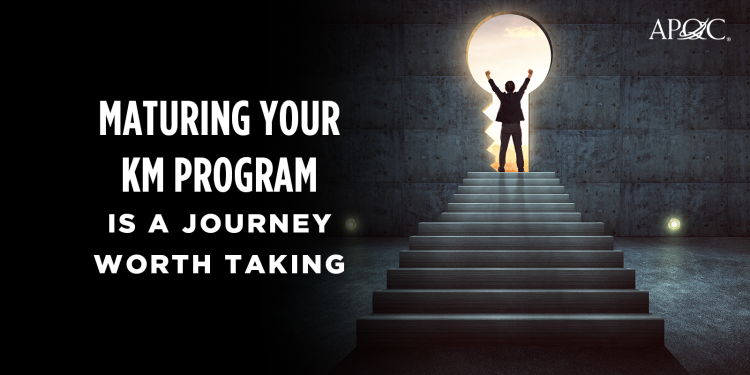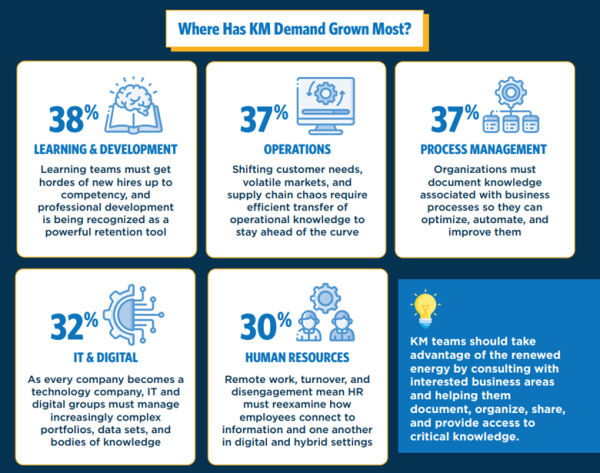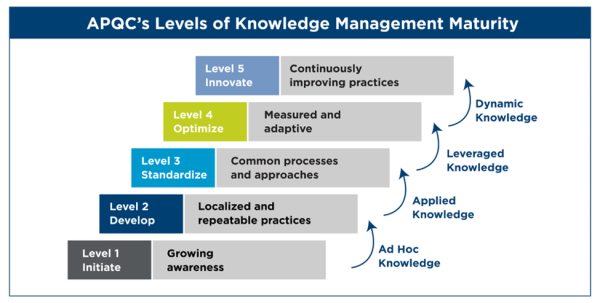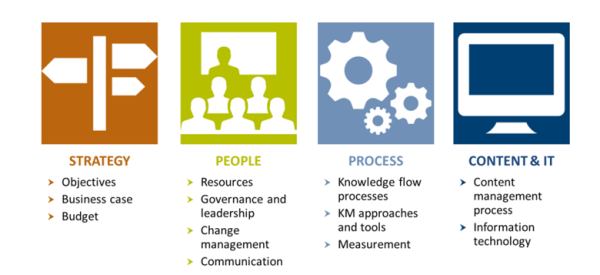
Several business functions such as digital, IT, and quality have industry assessments available to help them measure the effectiveness of their current capabilities, and knowledge management is no different. Whether you are kicking off a new knowledge management program or have been on a journey for years, understanding your current capabilities and gaps is essential for future success.
Across the board, we are seeing an increase in demand for knowledge management (KM) capabilities. And more recently in functions and business areas that provide enterprise-wide services to employees and departments.
So, why should you assess your organization’s KM maturity?
APQC’s 2023 trends and survey report revealed that increasing the maturity of KM programs and capabilities is one of the top priorities for KM professionals. Regardless of where you are in your KM journey, going through a holistic assessment process can help you understand your current capabilities, growth opportunities, and insights into creating a plan; giving you a head start in meeting organizational demands for KM. By utilizing an assessment, you will be able to:
- Create a Meaningful Baseline - In addition to clarifying the status of KM within an organization, a preliminary assessment provides a snapshot of base-level performance against which you can measure future progress.
- Gather Data and Collect Feedback - Data gathering helps you clarify how team members and stakeholders view KM performance and impact. The simple act of completing the assessment can provide valuable feedback.
- Validate Your Strategy - With detailed assessment results in hand, you can determine where you are achieving goals, what capabilities and successes you can build on, and where you may need to rethink your approach.
- Provide a Path Toward Consistency and Standardization - Conversations that take place during the data collection process and the assessment scores can reveal additional opportunities for standardization.
- Communicate Progress and Celebrate Success – Gain insight into the evolution of your organization’s KM capabilities over time, how the program is progressing, how it compares to industry peers and top performers, and celebrate where you are in the journey!
How can organizations assess their KM Maturity?
Almost a decade ago, APQC developed the Levels of KM Maturity™, a five-phased maturity model that describes the development of KM programs. The model progresses from Level 1, at which an organization starts to recognize the need to improve knowledge flow, to Level 5 at which KM processes and behaviors are fully embedded in enterprise strategy and culture.
The KM CAT (capability assessment tool) allows you to measure every aspect of your KM programs, from strategy and business case development to specific processes and technologies and find out how your program stacks up against the competition. The assessment is divided into four categories:
Companies who have been identified as “Excellence in KM” recipients in 2022 by APQC (reaching a level 3 maturity or higher), leveraged the KM maturity assessment to continue raising the value of their programs and increasing engagement with leaders and knowledge workers within their organizations.
Examples of best practice capabilities from our 2022 excellence in KM recipients:
- At Mercer, Knowledge Specialists aligned to the businesses work with subject matter experts (SMEs) and business leaders to align KM to business priorities, curate content, and guide collaboration and engagement efforts
- At Saudi Aramco, all employees learn the purpose of KM and how to use KM tools in their onboarding, and the core and local KM teams sustain engagement through regular awareness sessions and cross-channel communications
- At U.S. Navy Carrier Team One, KM is aligned with process improvement through knowledge sharing networks (KSNs).
What are some best practices to ensure you are continually maturing your KM program?
- Establish a cadence for using the KM-CAT
- Engage all KM team members, business SMEs, and leaders to complete the assessment
- Develop action plans and communicate progress to key stakeholders
- Partner with business leaders, SMEs, and community leaders on future plans
- Always shown alignment to organizational objectives
Understanding your current capabilities and continuing to align future practices to priority business objectives are keys to a successful KM program. To learn more about how to mature your KM program, check out these Eleven Practices of Highly Effective KM Programs and KM maturity resources at APQC.


